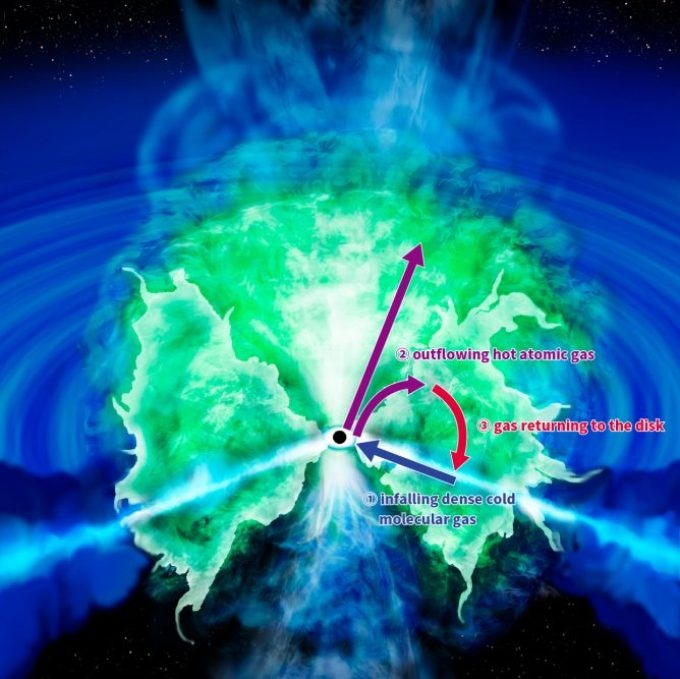Dec 3 2018
On the basis of computer simulations and new observations from the Atacama Large Millimeter/submillimeter Array (ALMA), scientists have discovered that the rings of gas surrounding active supermassive black holes are not just donut shapes. On the contrary, gas liberated from the center interacts with infalling gas to form a dynamic circulation pattern, analogous to a water fountain in a city park.
 Artist’s impression of the gas motion around the supermassive black hole in the center of the Circinus Galaxy. The three gaseous components form the long-theorized “donut” structure: (1) a disk of infalling dense cold molecular gas, (2) outflowing hot atomic gas, and (3) gas returning to the disk. (Image credit: NAO)
Artist’s impression of the gas motion around the supermassive black hole in the center of the Circinus Galaxy. The three gaseous components form the long-theorized “donut” structure: (1) a disk of infalling dense cold molecular gas, (2) outflowing hot atomic gas, and (3) gas returning to the disk. (Image credit: NAO)
In a majority of the galaxies, there exists a supermassive black hole, which is millions or billions of times as heavy as the Sun, at their centers. Some of these black holes devour materials very actively. However, astronomers have considered that instead of falling directly into the black hole, matter gets accumulated around the active black hole, thereby forming a donut structure.
Takuma Izumi, a scientist at the National Astronomical Observatory of Japan (NAOJ), headed a group of astronomers who used ALMA to observe the supermassive black hole in the Circinus Galaxy, located 14 million light-years away from the Earth in the direction of the constellation Circinus. Then, the astronomers compared their observations with a computer simulation of gas falling toward a black hole made with the Cray XC30 ATERUI supercomputer operated by NAOJ.
This comparison showed that the presumptive “donut” is in fact not a rigid structure; by contrast, it is a complex collection of highly dynamic gaseous components. Initially, cold molecular gas that falls toward the black hole develops a disk closer to the plane of rotation. When it gets nearer to the black hole, the gas gets heated until the molecules break down into the constituent atoms and ions. Then, some of these atoms are expelled above and below the disk, in contrast to being absorbed by the black hole. The hot atomic gas falls back onto the disk, thus forming a turbulent three-dimensional structure. The three components circulate continuously, analogous to a water fountain in a city park.
“Previous theoretical models set a priori assumptions of rigid donuts,” explained Keiichi Wada, a theoretician at Kagoshima University in Japan, who is a member of the research group and headed the simulation study. “Rather than starting from assumptions, our simulation started from the physical equations and showed for the first time that the gas circulation naturally forms a donut. Our simulation can also explain various observational features of the system.”
By investigating the motion and distribution of both the cold molecular gas and warm atomic gas with ALMA, we demonstrated the origin of the so-called ‘donut’ structure around active black holes,” said Izumi. “Based on this discovery, we need to rewrite the astronomy textbooks.
Keiichi Wada, Theoretician, Kagoshima University
Paper and the research team
These outcomes of the observation were published in the Astrophysical Journal as T. Izumi et al. “Circumnuclear Multiphase Gas in the Circinus Galaxy. II. The Molecular and Atomic Obscuring Structures Revealed with ALMA” in October 2018.
The members of the research team were Izumi Takuma (National Astronomical Observatory of Japan), Keiichi Wada (Kagoshima University/Ehime University/Hokkaido University), Ryosuke Fukushige (Kagoshima University), Sota Hamamura (Kagoshima University), and Kotaro Kohno (The University of Tokyo).
This study was supported by JSPS KAKENHI (Grant Numbers 17K14247, 16H03959, JP17H06130).